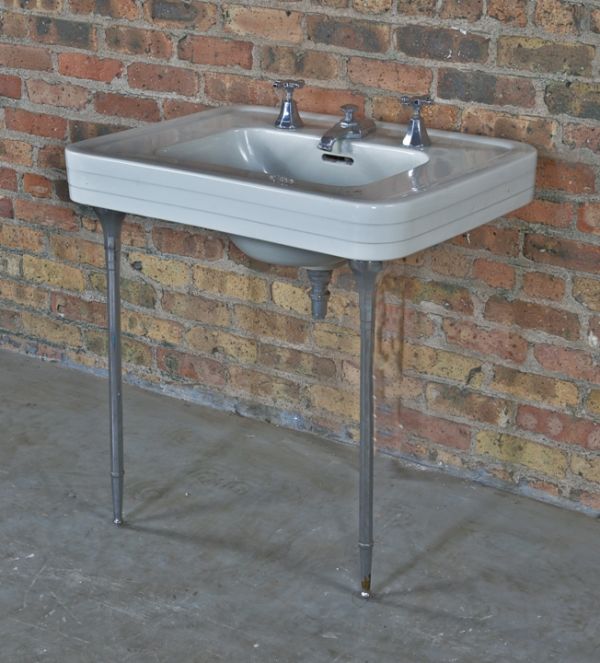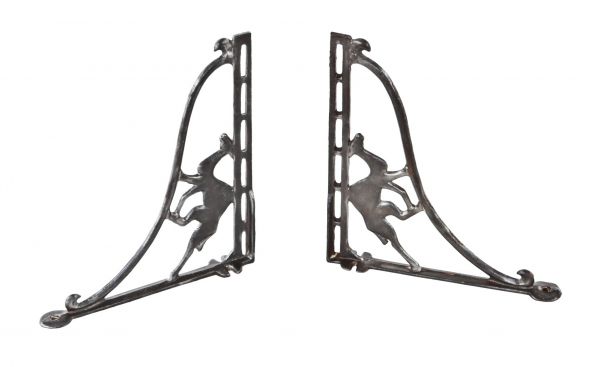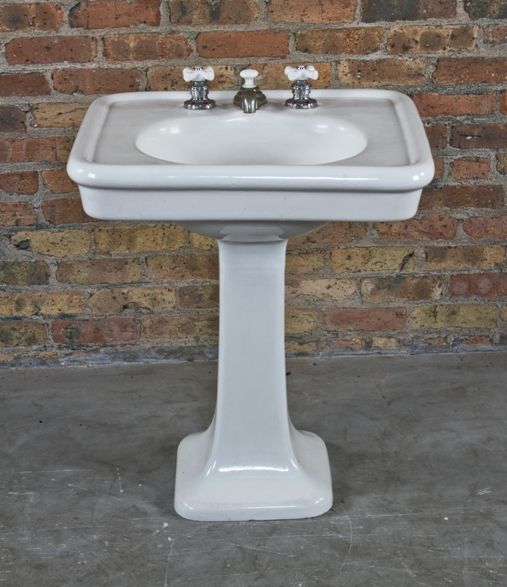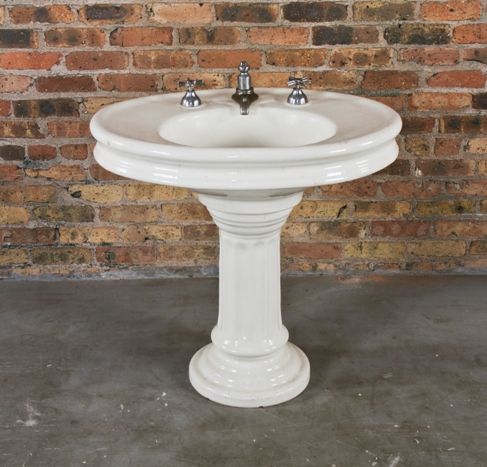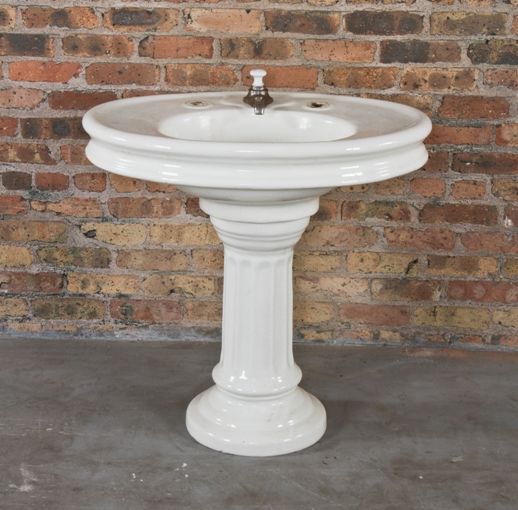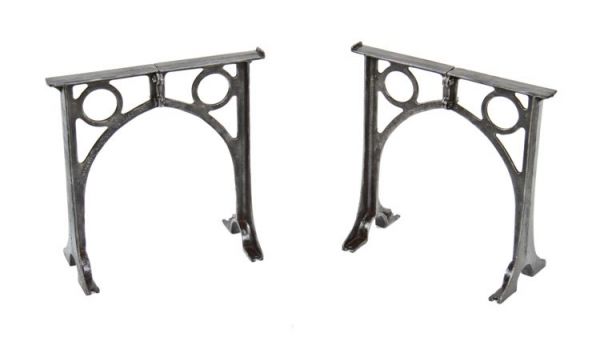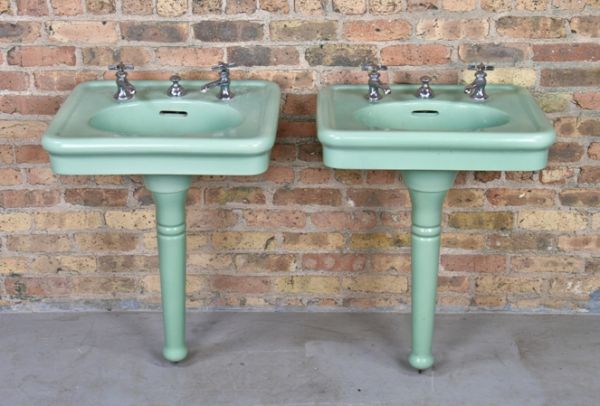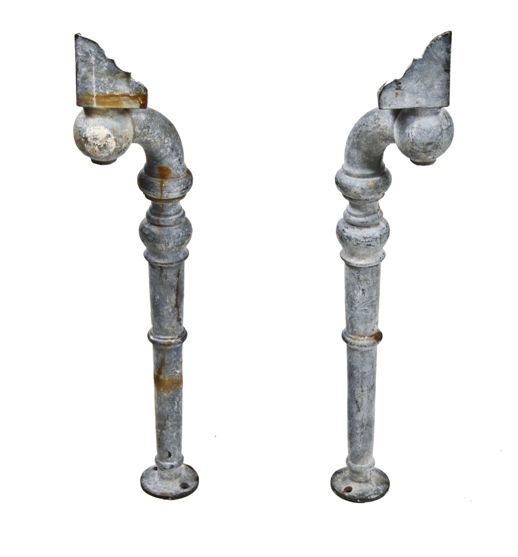original c. 1929 american art deco "conwith" pattern white vitreous china pedestal sink with original chrome plated fittings and pedestal legs
SOLD
Out of stock
SKU
UR-18850-13
crane company, chicago, il.
marvelous c. 1920's american art deco style "conwith" pattern heavy vitreous china pedestal sink designed and fabricated by the crane company, chicago, il. the interior lavatory sink was salvaged from the stately allen loeb mansion constructed in 1929. the white glazed porcelain sink contains a large opening with rounded edges and a unique tapered or "stepped" apron. the sink is supported by two fanciful heavy duty solid bronze pedestal legs with a polished chrome finish. the original adjustable brackets mounted on the back along the underside are intact. the uniquely shaped faucet and "cross" handles are original and comprised of bronze with polished chrome plated finish. the sink remains in excellent condition, considering age. the georgian revival style allen loeb mansion, located at 1427 waverly road (highland park, il.), was completed in 1929. the 10,200 square foot stately residence was designed by the architectural firm of walcott and work, although there is strong evidence that arthur heun may have initiated the original design. typical georgian revival homes are stately, rectangular, and often sheathed in red brick. this style was generally popular in the u.s. for estate houses from the turn of the century until the depression. a georgian facade is symmetrical and often emphasized by a pedimented projecting pavilion. sometimes the front entrance, which is typically located in the center of the pavilion, is surrounded by a one story, columned porch. a palladian window (three part window with a round arched sash in the center, flanked by two, often shorter, double hung sash) may be found above the pavilion. other classical details, such as dentils, modillions, and pilasters are prevalent. the partnership of russell walcott and robert work began in 1928 and lasted until 1936. as prominent area architects, they did extensive work on the north shore and had housing designs featured in national publications, including the russell kelly house in lake forest that was photographed in a november, 1931 edition of house & garden. jens jensen designed the surrounding landscape around the loeb residence and the neighboring home (as the houses changed hands over the years, subsequent owners wanted individual identities for their properties and removed much of the jensen landscape elements). the sprawling mansion with adjoining carriage house is comprised of hand-cut roman style limestone brick with a slate roof and spacious parking court. in interior featured paneled rooms, marble fireplaces, crystal chandeliers and a walk-in safe in the basement. allen loeb and his brother (who built a neighboring mansion that same year) were real estate and investment experts. together, they owned the non-extant chicago arena in downtown chicago, which was a riding stable and ice arena. in 1954 the arena was converted into cbs studios, where the first presidential debate was held. in 2009 the building was demolished. urban remains worked in conjunction with the wrecker to remove exterior and interior architectural elements. ernest and allen were the older brothers of richard loeb, who was found guilty in the murder of bobbie franks in 1924. at the time, the loeb family lived in the kenwood neighborhood in chicago. their father, albert loeb, was vice president of sears and was considered next‐in‐line to become the president. following the publicity of the murder, however, the family moved to highland park and albert died shortly afterward. the former owners of the house renovated the kitchen in 1973 and added a pool building onto the east side of the house in 1982. measures approximately 30 x 24 x 4 inches. The legs measures approximately 28 inches high.
You Might Also Like
WORDLWIDE SHIPPING
If required, please contact an Urban Remains sales associate.
NEW PRODUCTS DAILY
Check back daily as we are constantly adding new products.
PREMIUM SUPPORT
We're here to help answer any question. Contact us anytime!
SALES & PROMOTIONS
Join our newsletter to get the latest information

